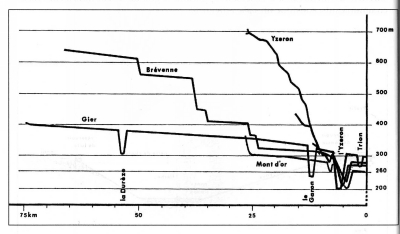
3. Design
Who made the design for the Roman aqueducts?Here a set of questions with relevant answers, some of which are linked to related subjects as discussed in other places within this website www.romanaqueducts.info
Additional questions or remarks are most welcome via w.d.schram 'at' romanaqueducts.info
Questions
- Where did the Roman aqueducts got their water from?
- Who made the design for the Roman aqueducts
- Did Roman aqueducts go over water (by bridge)?
- Could Roman aqueducts be underground?
Note the deep notches, respresenting the different siphons (La Durèze, Le Garon, L'Yzeron and the Trion) where the aqueducts made sharp bends down and up valleys.
Answer
The first step in aqueduct construction was to find a good water source, either a perennial spring or a river producing enough water during all seasons. Then surveyors came along, most of them with a military background, to set out a trace in which as few as possible expensive works of arts like tunnels and bridges were necessary. And remember, a regular slope was a must (less that 1%) otherwise the water could only reach the lower regions of the town. To cross wide valleys so-called siphons were built where temporarily the water was put into (lead or stone) pipes. This special system was even applied to cross rivers under water!Special surveying instruments were used like the groma, chorobates and the dioptra.
Perhaps land had to be bought from land owners, the trace had to be cleared and construction work could start under supervision of an engineer.
In general 80% of the trace was subterranean, so the more visible parts of an aqueduct like the bridges (Pont du Gard, Segovia-bridge) and arcades (around Rome) has drawn all the attention resulting in a wrong idea about what aqueducts are! The Bologna aqueduct for instance was even 100% subterranean.